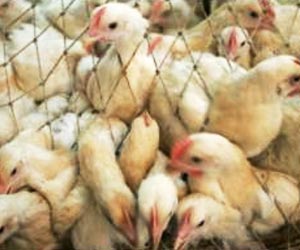One of the worlds poorest country Niger, has ordered the culling of poultry more than a month after the discovery of the out break of deadly avian flu.
The culling of poultry began in Niger one of the world’s poorest country, more than a month after it first discovered an outbreak of deadly avian flu near its southern border with Nigeria.
The semi-desert former French colony ordered the culling of all poultry in affected areas on February 28, the day after an outbreak of H5N1 was confirmed. It has now appealed for international help, as it lacked the resources to do the job.The state radio reported that the security forces have sealed off some 46 villages around Magaria, a town on Niger's southern border few kilometres from Nigeria, and only those wearing protective suits were allowed into the area, Environmental officials said other measures had been tightened as soon as the outbreak was confirmed, which included restrictions on the movement of poultry in the affected region and the isolation and permanent surveillance of some 20 farms around the country.
Health experts fear Africa's poor human and animal health services, large backyard poultry population, and lack of resources to fight bird flu make it an easy target for the disease, which has killed more than 100 people worldwide. They also fear lack of funding and international help could effect in the efforts to curtail its spread.
As much of the $US1.9 billion ($A2.6 billion) pledged at a bird flu summit in January was for Asia, the UN bird flu coordinator, David Nabarro, has said countries infected more recently, such as those in Africa, need more funds. According to the World Health Organisation, the virus has killed 109 people, most of them in Asia and involving people who had close contact with infected birds. Burkina Faso last Monday became the fifth African country to report the disease after Nigeria, Niger, Cameroon and Egypt. It has already started culling poultry in the area where the virus was discovered. While mainly affecting animals, scientists fear the disease could mutate into a form that could pass between humans, causing a pandemic.
Meanwhile in Kenya children, artists, performers and conservationists have gathered to celebrate World Migratory Bird Day. They met on the edge of the Great Rift Valley to try to counter the negative influence which bird flu has had on how people view migratory birds. Kenya's part of the Great Rift Valley - a vast geographical feature that runs from northern Syria to central Mozambique - is a haven for birds like flamingos, pelicans and storks, but is thought to be at risk from bird flu. Millions of birds migrating from Asia to the northern hemisphere stop here to enjoy the freshwater ponds, dams and lakes, all possible conductors for the avian flu virus.
The role of migratory birds versus the trade in bird products in the spread of avian flu has also been the source of much debate, with conservationists contending the disease's spread has not closely followed known bird migrations.The scientists have not yet reached a consensus on the issue.
Advertisement
Meanwhile in India a six-member team of trappers and ornithologists sent by the Bombay Natural History Society (BNHS) has finally got the clearance after a long wait to trap birds, for the Forest Department’s permission. This clearance unfortunately has come a little late, as from 13,000 bar-headed geese, which were, there till February there are less than 300. The birds fly away from March-end to early April. Internationally, bar-headed geese are being studied as potential carriers of the virus, since many died in a bird flu outbreak at Qinghai Lake, China, last May.
Advertisement



